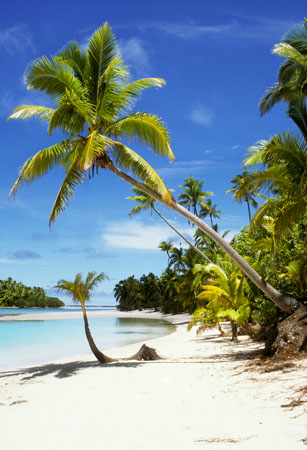Islands in tropical regions usually have endless sunshine, beautiful beaches, palm trees, and a profusion of colourful flowers, birds and fishes. Most also have pristine white sand, turquoise waters and stunning blue skies that captivate the eye and defy description. The smaller ones engender a greater sense of isolation, and have a more discernable intimacy and ambience. In some cases it may be possible to capture the feeling of these idyllic surroundings in a single image.
 The simple natural beauty of island locations is relatively easy to capture. Look for attractive compositions incorporating the characteristic blues and greens, the beauty of palm trees and other vegetation, the curve of the shoreline and any splash of red or yellow that might be available. Palm trees cast particularly beautiful shadows onto sand and water, and these can sometimes make very attractive images. Finally, check that the horizon is level in the viewfinder. On location the brain tends to find a compromise between the slope of the beach, the leaning palms and the horizontal surface of the sea, but images that show sloping water just don’t look right.
The simple natural beauty of island locations is relatively easy to capture. Look for attractive compositions incorporating the characteristic blues and greens, the beauty of palm trees and other vegetation, the curve of the shoreline and any splash of red or yellow that might be available. Palm trees cast particularly beautiful shadows onto sand and water, and these can sometimes make very attractive images. Finally, check that the horizon is level in the viewfinder. On location the brain tends to find a compromise between the slope of the beach, the leaning palms and the horizontal surface of the sea, but images that show sloping water just don’t look right.
The light on tropical beaches is intense, contrast is high, and the substantial glare from both sand and water may fool your camera into underexposing the scene. Automatic exposures tend to produce grey sand and trees, rocks and people may be reduced to little more than silhouettes. One solution is to use the camera’s exposure compensation feature to overexpose by one or two stops. Another is to work early or late in the day when the sun is at a lower elevation, the light is less harsh and contrast is reduced. The gentler atmosphere provided by the warmer light and longer shadows not only reveals depth and texture but also emphasizes the relaxed environment. Try to find a bay with a beautiful shape, or a sandy point where the island slides into the lagoon, and then look for an isolated palm tree or a local boat drawn up onto the sand. With the sun on your back the colours will be wonderful. With the sun setting in front of you the silhouettes are breathtaking and the water may turn orange or silver.
Polarizing filters are used for many of the travel photographs seen in holiday brochures. They reduce the amount of reflected light entering the lens in bright light and consequently intensify colours. The blues of the sky and sea become more intense, and the colours of flowers, foliage and other objects become richer and more vibrant. Care must nevertheless be taken to ensure that the effect is not overdone. Skies can be over-polarized and rendered too dark, particularly with films that normally produce saturated colours. Maximum polarization, and hence the darkest blue sky, occurs at right-angles to the direction of the light, but the effect is not even. Consequently, when using a wide-angle lens, the intensity of a blue sky may change significantly across the frame. Colours are so intense in this environment that a further boost may prove excessive. Use a polarizer judiciously where glare makes it necessary, but be prepared to settle for less than the maximum effect.
Beaches are generally a hostile environment for camera equipment, but those in the tropics are perhaps the worst of all. Cameras and lenses are not only exposed to the hazards of sand and salt but also to humidity and sweltering heat. Keep valuable items in a camera bag when they are not in use, and never leave the bag on hot sand or in direct sunlight.






